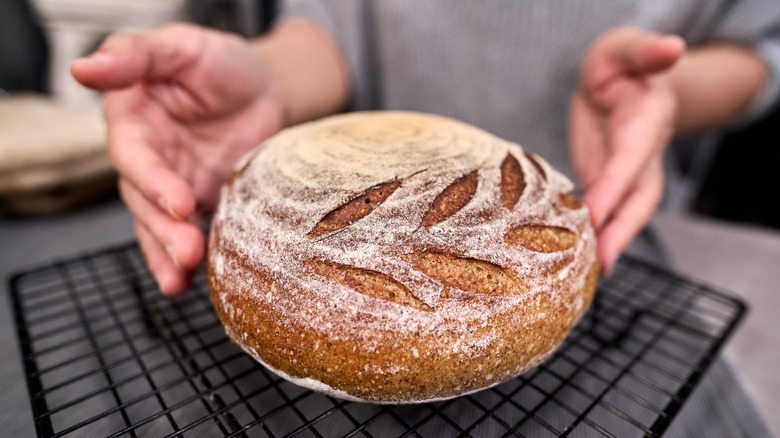The Key To Scoring Sourdough Bread Perfectly Every Time
Whether you started making sourdough bread during the pandemic or you've just started to dip your toes in these waters recently, baking a loaf is a whole project in itself. But, as time-consuming and laborious as it is (a fresh-baked sourdough recipe can take upwards of 30 hours from start to finish), there are many tips and tricks you can follow to make your process easier and more efficient. One of the more fun ones? Using a turntable to score your dough.
Not only is scoring important for releasing air and building the structure of your loaf (hence why skipping out on this step is a common bread baking mistake), but it's what makes those pretty designs on your finished product. When you get into the more complicated patterns beyond a simple slash, however, it's endlessly helpful to have a rotating base for your dough. This way, you can spin it as needed without having to crane your arms around the opposite side or mess up your ball by lifting it. If you don't have a turntable that's used for making cakes at home, you can also try a lazy Susan, a cake stand, or even the plate from your microwave.
A bread lame makes for straight slashes
Once you've got your rotating device in place, you'll want to score your bread from the top down. Why? When you're using a lame, aka a mini razor blade with a handle that is made for this exact purpose, it's a much smoother motion to slash straight down instead of trying to fight your way through the dough from bottom to top. If you don't own a lame, a paring knife makes for an easy alternative, but these tools are so small and affordable that you may want to purchase one if you're an avid bread baker. When making your cuts, go quickly and confidently to avoid dragging your dough. Ensure that your razor is appropriately sharpened as well. Practice makes perfect when it comes to scoring (it truly is an art form, after all), so feel free to conduct some test runs on paper beforehand.
Another tip that makes the scoring process easier has nothing to do with the surface or tool you use but rather the temperature of the dough. As you may imagine, warm dough is more malleable, so it may bend to your blade instead of producing clean cuts. Dough that has been chilled a little bit right before scoring, however, may be much easier to work with. Then, once you've made your slices, bake your loaf immediately to avoid deflating it.

